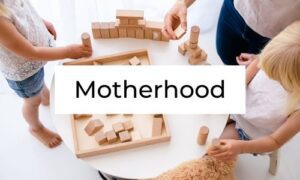This is part two in a series about decluttering called “Cut Through Clutter.” To read part one, go to Cut Through Clutter by Understanding the Psychology Behind It.
Last week, we explored clutter and the psychology behind it. This week, we are going to start diving into the process with the best books about decluttering.
If you’re feeling boxed in by the amount of clutter in your home, you’ve likely come to the realization that it’s time to make a change, and that’s what this series is all about.
Throughout “Cut Through Clutter” we are exploring why you should declutter, tips on the process, and even ways to manage the stress of decluttering.
Because I get it and I’m right there with you…it’s hard to get rid of things, especially as a parent. Everything my daughter touches is somehow precious and I can’t bare to part with it!
But, if you’re anything like me, you’ve probably thought about what life could be like if you reclaimed your space, making it clean and organized.
However, decluttering requires getting rid of stuff, and parting with possessions can be one of the most emotionally overwhelming experiences for some people.
Fortunately, there are tons of books and creative ways to make the process easier.
Top professional organizers have developed systems for breaking the process down and making it seem more bearable and compiled it into neat little books about decluttering.
Keep reading to learn the best books about decluttering and the methods of minimalist masters.

The #1 Best Book About Decluttering – The KonMari Method
You’ve probably been sleeping under a rock if you haven’t heard of Marie Kondo. Or, maybe you are just in a room packed full of clutter, I don’t know.
But, in all seriousness, Marie Kondo is considered by many to be a decluttering guru.
Author of The Life-Changing Magic of Tidying Up, which has sold over four million books, it’s definitely worth considering her “magic.”
She even has a Netflix show too, Tidying Up with Marie Kondo.
Of all the best books about decluttering, this is probably the best of the best for a lot of people.
Kondo’s method involves focusing on what to keep, rather than what to toss.
The core principles involve categorizing your items, and then taking time to sort through each category with the mindful intention of keeping only the ones that bring you joy.
Kondo’s detailed guide helps you through the process, but in a nutshell, it works like this:
If you’re a collector of mugs, for example, place all of your pieces on the table or counter. Pick up and inspect each, carefully determining which ones you love for their unique characteristics or sentimentality.
Then box up the rest to donate or sell.
It’s not just looking at something and asking if it brings you joy, it’s sorting through things and categorizing items too.
Project 333 – A Minimalist Fashion Challenge
For a lot of us, clothes are a big problem when it comes to clutter.
I know I have tons of old t-shirts, work clothing from the days I went into the office, and now maternity clothes that I haven’t worn in years (but I keep telling myself I’m holding on to them because I don’t know what the future holds in that department).
And, that’s where Project 333: The Minimalist Fashion Challenge That Proves Less Really is So Much More comes in.
Author Courtney Carver, a minimalist expert, takes on a decluttering approach starting with your wardrobe.
In Project 333, you are challenged to only use 33 pieces of clothing from your closet for 3 months.
At first, it sounds a bit shocking, but if you think about it, how many items in your closet are you actually wearing?
Filled with tons of tips and solutions to manage your closet and consumerism, this book is life-changing in the sense that it shows you that you’re more than what you wear.
You can also find more information about the book and additional challenges and information at Carver’s website.
Cut through clutter series tip #2 – Don’t try a bunch of different decluttering methods. Pick ONE that resonates with you and try that one first. Stick with it for a few weeks, then change methods if it’s not working for you.
The Best Book About Decluttering That’s Not a Book
Colleen Madsen of, 365 Less Things, has a brilliant approach to paring down possessions.
She decided at the beginning of 2010 to make minimalism her resolution by giving away or selling one item each day for the entire year.
Madsen documents both the physical results of the project as well as the psychological aspects on her blog.
Since then, thousands have taken on the simple challenge.
And, that’s the beauty of this one, in particular, is that you can make it what you want. Getting rid of one thing a day is not hard, but over time, it adds up to something big.
Even if you just got rid of one piece of paper (like old bills or receipts) a day for a whole year it would make an impact.
So, if the thought of decluttering scares you or causes you to panic, explore Madsen’s blog and consider taking on this simple approach to decluttering.
The Minimalists
The brainchild of Joshua Fields Millburn and Ryan Nicodemus of the popular blog of the same name, The Minimalists: Live a Meaningful Life is a great book about the concept of minimalism and what it can actually do for you.
This is more of an inspirational book on decluttering and how it can affect your life in a positive way.
But, what’s more, Millburn and Nicodemus have created an entire blog and website with a variety of challenges/methods to decluttering and living a minimalist lifestyle that you can easily implement (with or without buying their book).
First, you can play the Minimalist Game.
Find a friend or family member who’s willing to do this with you for the next month too (it makes it more fun and keeps you both accountable!).
The way it works is on the first day of the month, choose to get rid of one item. On the second day, you get rid of two items, on the third day you get rid of three items. And, so on and so on.
Giving away one thing on the first day is easy, but can you come up with 20 things to get rid of on the 20th day of the month?
What about 31 things to part with on the last day of the month?
Those who stick with it will have a home with 496 fewer pieces or clutter. Making it a challenging competition with friends or family ups the stakes too…can you stick with it?
Second, you can do a Packing Party. (Because as Nicodemus says, “Everything is more fun when you put ‘party’ at the end.”)
A “Packing Party” is just like it sounds. You put all your stuff into boxes as if you were moving.
Everything.
Seriously.
Then after everything is packed up, you only unpack the items needed over the next three weeks.
In doing this exercise, Nicodemus discovered that after three weeks, 80% of his stuff was still packed away in boxes.
And, then he donated all that unopened stuff.
WOW.
That’s a bit extreme for me. But, I do think it’s an exercise to try if you have an excess of things.
At the end of the day, what do you actually use on a daily basis? What do you actually need?
The hundreds of books we have sitting on shelves, the boxes of old photos, the piles of our children’s artwork we are hoarding. What’s the point of it all?
And, that’s kinda the whole point of minimalism in general and what Millburn and Nicodemus explore in their book and on their blog.
The Best Books About Decluttering – Clearing Mental Clutter
Peter Walsh is an organization expert who has written dozens of books about decluttering and organization. And, he’s appeared on Oprah (back in the day) and The Rachael Ray Show.
“Taking a very different approach to other professional organizers, Peter believes that clutter is anything that stands in the way of people living their best lives.”
And, that’s why I’m highlighting Walsh on this list, specifically his book Enough Already!: Clearing Mental Clutter to Become the Best You.
Because, as we learned in part 1, clutter isn’t always physical. There is digital and even mental clutter too.
And, that’s what this book explores more than the others on this list, is the psychology of clutter. Walsh believes that there are six main areas of a person’s life (family, relationships, work, health, money, and faith) and these areas are all interconnected.
If one area of your life is cluttered, the other areas of your life will inevitably become cluttered too.
But, this book takes a turn focusing on how to manage those areas from a mental and emotional aspect.
It’s almost like a self-help book with a decluttering theme or analogy.
And, it’s interesting to think about mental clutter and how you can declutter your mind which can then lead to decluttering actual things too.

These are just five of the many decluttering books out there as well as some creative methods to help you begin the decluttering process.
Of course, there are tons and tons of other decluttering books out there.
But, these books are from experts that have some of the best and most tangible methods for decluttering to make it easier.
And many of the methods can easily be done with the whole family, including kids, which is important to me as a parent.
Teaching your child the value of things we buy and use are all important life skills. And, getting them involved with donating old clothes or toys is a great way to help them understand the concept of getting rid of things that we no longer use or need.
As we look toward the next part in this series, “Cut Through Clutter,” I encourage you to pick one of these books or methods that resonates with you and prepare for the next post in the series: Decluttering Made Easy with Four Tips.









2 thoughts on “5 of the Best Books About Decluttering”
Awesome suggestions! Decluttering is so important. Thanks for sharing!
Yes it is and there are some really simple and easy methods that make it way more manageable! Thanks for checking out the post!